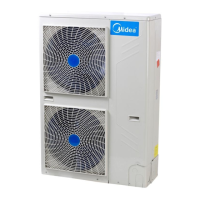2 Errors
2.1 Error Code Table
Table 4.1: Error code table
DEF./FAN LED flashes rapidly
Communication error between indoor and outdoor units
TIMER LED flashes rapidly
Indoor ambient temperature sensor error
OPERATION LED flashes rapidly
Indoor heat exchanger mid-point temperature sensor
error
OPERATION LED flashes rapidly
Indoor heat exchanger outlet temperature sensor error
OPERATION LED flashes rapidly
DEF./FAN LED flashes slowly
ALARM LED flashes rapidly
Indoor unit has not been assigned an address
OPERATION and TIMER LEDs flash
Notes:
1. Flashing rapidly means flashing twice per second; flashing slowly means flashing once per second.
2. In the event of a louver swing failure, no error code is displayed. For troubleshooting guidance for louver swing failure, refer to 5.10 “Louver Swing
Failure Troubleshooting”.
2.2 Impact on Other Units
Table 4.2 shows the impact of an error on one indoor unit on the outdoor units and on the other indoor units in
the system. The actual state of the outdoor units and the other indoor units is determined not only by the impacts
shown in Table 4.2, but also by any other errors that may have separately arisen on the outdoor units or other
indoor units.
Table 4.2: Impact of indoor unit error on outdoor units and on other indoor units
Impact on other indoor units
Notes:
1. The outdoor units continue to operate and ignore the load requirement from the indoor unit that
has gone into mode conflict with the outdoor units.
2. Outdoor unit error code H7 indicates that the number of indoor units detected by the master
outdoor unit is not the same as the number set on the master outdoor unit’s main PCB.
3. Error Ed may not be displayed on the other indoor units. Indoor unit error codes have the following
order of priority: FE-E1-E2-E3-E4-E6-E7-Ed-EE-E0. So if, for example, one unit has an E2 error, it
continues to display E2 even if an E1 or FE error occurs on another indoor unit (giving rise to an
outdoor unit H7 error) since error Ed is lower in the order of priority than error E2.
4. The outdoor units continue to operate but detect no load requirement from the indoor unit that
has experienced an E2, E3, E4, E6, E7 or EE error, and adjust their output accordingly, in the same
way as they do when a user puts an indoor unit into standby.
5. An indoor unit Ed error is caused by (and not the cause of) an outdoor unit error. The outdoor units
will be displaying their own error code.

